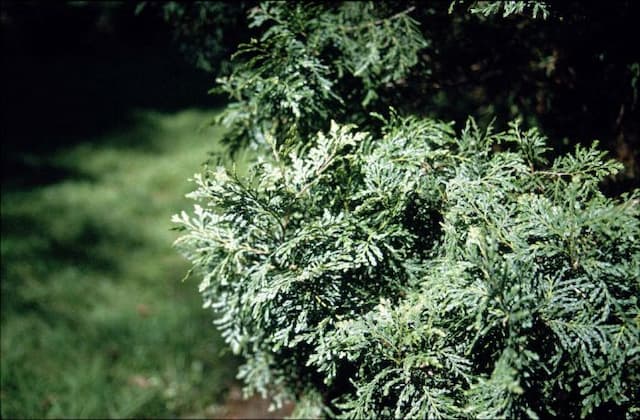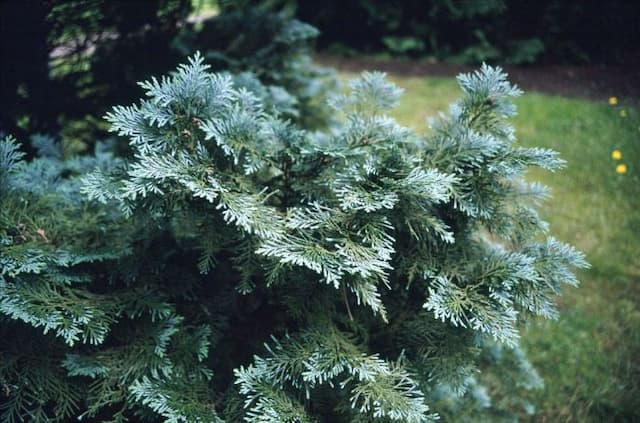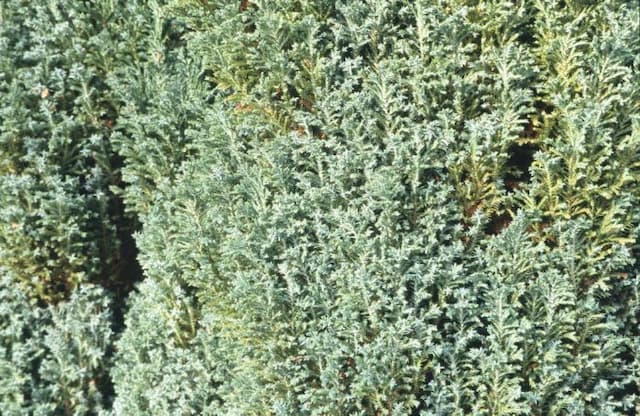Irish Juniper Juniperus communis 'Hibernica'

ABOUT
Juniperus communis 'Hibernica', commonly known as the Irish Juniper, is a coniferous evergreen plant that boasts a distinctively narrow, columnar form. It is characterized by dense clusters of needle-like leaves that possess a rich green hue, making it a prominent ornamental addition to various landscapes. The leaves are typically arranged in whorls of three and can have a slightly prickly texture upon closer inspection. As the Irish Juniper matures, it produces small, berry-like cones which are initially a green color, transitioning to a more bluish-black shade upon ripening. Each berry is often adorned with a whitish bloom, which adds a subtle contrast to the overall appearance. These berries are not only eye-catching but also attract wildlife, offering a source of food. The bark of the Irish Juniper has a fibrous texture, which can peel off in narrow strips, complementing its rustic look. The plant's rigorous evergreen foliage provides year-round interest, with its needled leaves releasing a pleasant aroma when crushed. These leaves may also shift to take on a slight bronze tone during colder months, adding further visual interest to winter landscapes. The Irish Juniper is admired for its vertical prominence and structural silhouette, lending itself well to formal garden designs, tight spaces, and as a natural screen or windbreak. It is a symbol of endurance and rugged beauty, able to withstand various environmental conditions. Overall, the Irish Juniper's distinguished shape and vibrant leaves create a striking visual statement in any setting where a tall, slender plant is desired.
About this plant
 Names
NamesFamily
Cupressaceae
Synonyms
Irish Juniper, Hibernica Juniper
Common names
Juniperus communis var. hibernica, Juniperus hibernica.
 Toxicity
ToxicityTo humans
The common juniper (Juniperus communis) has some degree of toxicity to humans. While the ripe berry-like cones are used to flavor gin and are generally regarded as safe to consume when fully mature and used in small amounts, other parts of the plant can be toxic. Consuming large quantities of juniper berries can lead to kidney damage and irritation of the gastrointestinal tract. Unripe berries, leaves, twigs, and other plant parts contain compounds that can be harmful if ingested. Symptoms of juniper toxicity may include stomach upset, diarrhea, and kidney irritation.
To pets
The common juniper (Juniperus communis) is also mildly toxic to pets. If pets consume parts of the plant, they could experience gastrointestinal upset, leading to symptoms such as vomiting, diarrhea, and abdominal pain. Ingesting large amounts could potentially cause more severe issues like kidney damage. It is advisable to keep pets away from this plant to prevent the possibility of poisoning.
 Characteristics
CharacteristicsLife cycle
Perennials
Foliage type
Evergreen
Color of leaves
Green
Height
10-15 feet (3-4.5 meters)
Spread
2-3 feet (0.6-0.9 meters)
Plant type
Shrub
Hardiness zones
2-6
Native area
Europe
Benefits
 General Benefits
General Benefits- Landscape aesthetics: Juniperus communis 'Hibernica', also known as Irish Juniper, has a visually appealing conical shape and rich green foliage that adds elegance and structure to garden designs.
- Low maintenance: Irish Juniper requires minimal care once established, making it an ideal plant for low-maintenance landscapes.
- Drought tolerance: This plant is highly tolerant of drought conditions, reducing the need for regular watering and making it suitable for xeriscaping.
- Cold hardiness: Irish Juniper is capable of withstanding cold temperatures, making it a durable choice for gardens in cooler climates.
- Wildlife support: It provides shelter and nesting sites for birds, as well as food in the form of its berries for various wildlife species.
- Soil stabilization: The extensive root system of Irish Juniper helps to prevent soil erosion, particularly on slopes and in areas prone to erosion.
- Privacy and windbreaks: Due to its dense foliage and growth habit, Irish Juniper can serve as an effective privacy screen or windbreak when planted in rows or groups.
 Medical Properties
Medical Properties- Diuretic: Juniper berries from Juniperus communis can promote urine production, aiding in the body's elimination of excess fluids.
- Antiseptic: The essential oils found in juniper have antiseptic qualities, which can be beneficial in treating infections, especially in the urinary tract.
- Antirheumatic: Juniper has been traditionally used to help relieve rheumatic pain and inflammation.
- Gastrointestinal remedy: It has been used to stimulate appetite, ease stomach upset, and relieve gas.
- Antifungal: Juniper can inhibit the growth of certain fungi, potentially useful for treating fungal infections.
- Anti-inflammatory: Juniper may help reduce inflammation, though this use is not well-documented with modern clinical evidence.
- Antioxidant properties: Compounds in juniper berries may act as antioxidants, neutralizing free radicals in the body.
 Air-purifying Qualities
Air-purifying QualitiesThis plant is not specifically known for air purifying qualities.
 Other Uses
Other Uses- Juniper wood is often used for creating small decorative objects such as jewelry boxes, due to its fine texture and pleasant scent.
- The berries of the Juniper are commonly used as a flavoring agent in gin production, offering a distinct and aromatic flavor.
- In certain cultures, the branches and berries are used for making herbal sachets to repel moths and insects from clothing.
- Juniper wood smoke imparts a unique flavor when used for smoking meats and fish in culinary practices.
- Traditional crafters use juniper wood to carve utensils, such as spoons and bowls, which are valued for their durability and aroma.
- The dense foliage of juniper can provide excellent shelter for birds and other wildlife in gardens and natural habitats.
- During Christmas, juniper branches are sometimes used in holiday wreaths and garlands for their robust greenery and pleasant fragrance.
- Juniper wood chips and sawdust are utilized in gardening as a mulch to help retain soil moisture and deter weeds.
- In landscaping, Juniper is planted as a ground cover or erosion control due to its hardy and spreading growth habit.
- Artisans may use the burl wood of juniper for creating unique turned wooden bowls and other artistic pieces, valued for its interesting patterns.
Interesting Facts
 Feng Shui
Feng ShuiThe common Juniper is not used in Feng Shui practice.
 Zodiac Sign Compitability
Zodiac Sign CompitabilityThe common Juniper is not used in astrology practice.
 Plant Symbolism
Plant Symbolism- Protection: Junipers are often believed to ward off evil spirits and negative energies, due in part to their evergreen nature and sturdy presence.
- Cleansing: The plant's aromatic wood and leaves have been used for smudging in various cultures, symbolizing the cleansing of a space or individual from negativity or sickness.
- Healing: Juniper berries have been used medicinally, symbolizing health and wellbeing, as well as the power of nature to heal.
- Purity: The clear, sharp scent of the juniper is thought to symbolize purity and is used in rituals to maintain a pure mind, body, and soul.
- Longevity and Endurance: As junipers are long-lived and can grow in challenging environments, they are often seen as symbols of endurance and the ability to thrive despite hardships.
- Fertility: In certain cultures, the juniper's robust seed production and survival skills are emblematic of fertility and the continuation of life.
 Water
WaterThe Irish Juniper should be watered deeply but infrequently, as it prefers well-drained soil and does not tolerate oversaturation. Typically, watering once a week during dry conditions with approximately 1-2 gallons of water should suffice for an established plant. During the growing season in spring and summer, a slight increase in frequency may be beneficial, but always ensure the soil has dried out between watering sessions. It's important not to waterlog the soil, especially during winter months, to prevent root rot. The exact amount of water may vary depending on soil type and temperature conditions.
 Light
LightThe Irish Juniper thrives in full sunlight and should be placed in a location where it can receive at least six hours of direct sunlight daily. It can tolerate partial shade but its growth may be less vigorous. The ideal spot for the Irish Juniper would be an open area away from tall buildings or trees that could cast shade on it for extended periods of the day.
 Temperature
TemperatureThe Irish Juniper is hardy and can withstand a wide range of temperatures, but ideally it grows best in conditions ranging from 40 to 70 degrees Fahrenheit. It can survive winter temperatures down to -30 degrees Fahrenheit and summer temperatures up to 90 degrees Fahrenheit without issues if properly acclimated.
 Pruning
PruningPruning the Irish Juniper is necessary to maintain its conical shape and to ensure healthy growth. It is best to prune in late winter or early spring before new growth begins. Pruning can be done annually or as needed to remove dead or diseased branches and to shape the tree. Always use clean, sharp tools to make precise cuts and avoid extensive pruning in any single year.
 Cleaning
CleaningNot needed
 Soil
SoilIrish Juniper prefers well-draining, sandy soils with a slightly acidic to neutral pH, typically between 6.0 and 7.5. A mix of one-third topsoil, one-third peat moss, and one-third sand or perlite would be ideal to promote good drainage and replicate its natural growing conditions.
 Repotting
RepottingIrish Juniper, being a slow-growing conifer, does not require frequent repotting. It should be repotted every 3 to 4 years or when it becomes root-bound, ideally in the spring before the onset of new growth.
 Humidity & Misting
Humidity & MistingIrish Juniper is well-suited to outdoor conditions and does not require high humidity levels. It thrives in average atmospheric humidity and can tolerate dry air, making it adaptable to most outdoor environments without the need for specific humidity adjustments.
 Suitable locations
Suitable locationsIndoor
Provide bright light, cooler temps, and good air flow.
Outdoor
Full sun, well-draining soil, protect from strong winds.
Hardiness zone
2-7 USDA
 Life cycle
Life cycleIrish Juniper (Juniperus communis 'Hibernica') begins its life cycle as a seed, which requires stratification through cold temperatures to break its dormancy. After germination, it enters the seedling phase, where it establishes roots and produces juvenile needle-like foliage. As it grows into a young plant, the Irish Juniper develops its characteristic columnar form and starts to produce adult scale-like leaves. The tree reaches maturity after several years, typically developing reproductive structures such as cones; the male cones release pollen while the female cones, upon fertilization, will grow into berries. These berries then mature over two to three years before dropping to the ground, potentially germinating new seedlings and continuing the cycle. Throughout its life, which can span several centuries, the Irish Juniper undergoes periodic growth and dormancy phases, adapting to seasonal changes.
 Propogation
PropogationPropogation time
Late winter to early spring
Propogation: Juniperus communis 'Hibernica', commonly known as Irish Juniper, is most effectively propagated through seed sowing. This process is typically done in the fall to align with the juniper’s natural seed drop and cold stratification process. Seeds are first harvested from ripe cones and then cleaned. Before planting, it is essential to stratify the seeds, mimicking winter conditions, by placing them in a moist sand mixture and refrigerating them at about 34 to 41 degrees Fahrenheit (1 to 5 degrees Celsius) for approximately two to three months. After stratification, the seeds are sown in a light, well-draining soil mix and should germinate in the spring when temperatures are consistently above 50 degrees Fahrenheit (10 degrees Celsius). Patience is key, as Irish Juniper seeds can take a long time to germinate, and growth in the initial years is typically slow.









